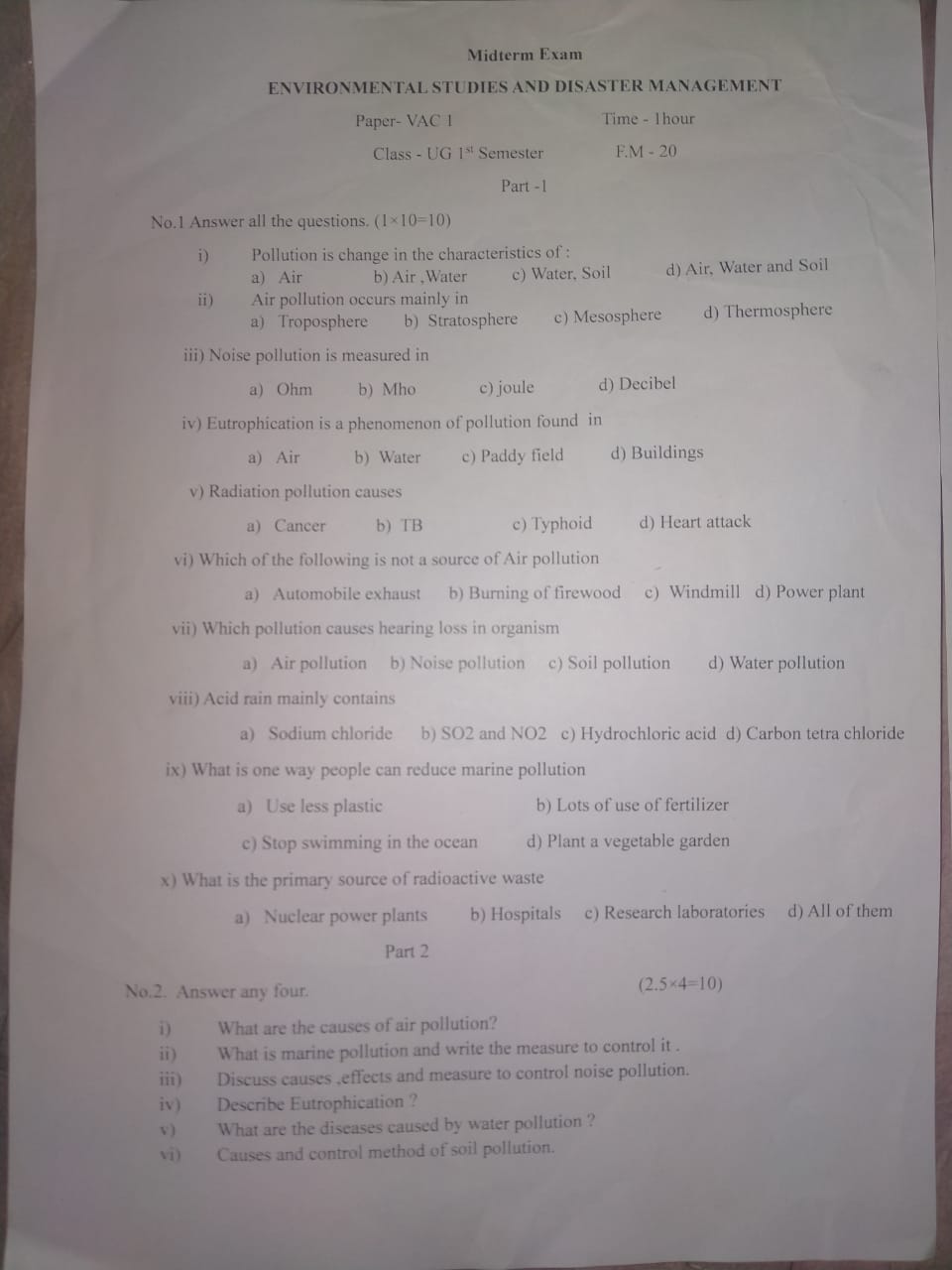Midterm Exam Environmental Studies and Disaster Management. Answer all the questions. 1) Pollution is change in the characteristics of: a) Air b) Water c) Soil d) Air, Water and So... Midterm Exam Environmental Studies and Disaster Management. Answer all the questions. 1) Pollution is change in the characteristics of: a) Air b) Water c) Soil d) Air, Water and Soil. 2) Air pollution occurs mainly in: a) Troposphere b) Stratosphere c) Mesosphere d) Thermosphere. 3) Noise pollution is measured in: a) Ohm b) Mho c) joule d) Decibel. 4) Eutrophication is a phenomenon of pollution found in: a) Air b) Water c) Paddy field d) Buildings. 5) Radiation pollution causes: a) Cancer b) TB c) Typhoid d) Heart attack. 6) Which of the following is not a source of Air pollution: a) Automobile exhaust b) Burning of firewood c) Windmill d) Power Plant. 7) Which pollution causes hearing loss in organism: a) Air pollution b) Noise pollution c) Soil pollution d) Water pollution. 8) Acid rain mainly contains: a) Sodium chloride b) SO2 and NO2 c) Hydrochloric acid d) Carbon tetra chloride. 9) What is one way people can reduce marine pollution: a) Use less plastic b) Lots of use of fertilizer c) Stop swimming in the ocean d) Plant a vegetable garden. 10) What is the primary source of radioactive waste: a) Nuclear power plants b) Hospitals c) Research laboratories d) All of them. Part 2. Answer any four. 1) What are the causes of air pollution? 2) What is marine pollution and write the measure to control it. 3) Discuss causes, effects and measure to control noise pollution. 4) Describe Eutrophication? 5) What are the diseases caused by water pollution? 6) Causes and control method of soil pollution.

Understand the Problem
The question pertains to Environmental Studies and Disaster Management, focusing on various kinds of pollution, their causes, and measures for control. It includes multiple-choice questions and open-ended questions for detailed explanations.
Answer
1) d 2) a 3) d 4) b 5) a 6) c 7) b 8) b 9) a 10) a
- d) Air, Water and Soil. 2) a) Troposphere. 3) d) Decibel. 4) b) Water. 5) a) Cancer. 6) c) Windmill. 7) b) Noise pollution. 8) b) SO2 and NO2. 9) a) Use less plastic. 10) a) Nuclear power plants.
Answer for screen readers
- d) Air, Water and Soil. 2) a) Troposphere. 3) d) Decibel. 4) b) Water. 5) a) Cancer. 6) c) Windmill. 7) b) Noise pollution. 8) b) SO2 and NO2. 9) a) Use less plastic. 10) a) Nuclear power plants.
More Information
These answers address environmental pollution concepts, measuring units, and control strategies. They highlight pollution's theoretical and practical implications.
Tips
Understand different pollution types and their specific characteristics, effects, and control measures.
Sources
- Pollution is an undesirable change - Chegg - chegg.com
- ENVIRONMENTAL-SCIENCE-1.pdf - vardhaman.org
AI-generated content may contain errors. Please verify critical information